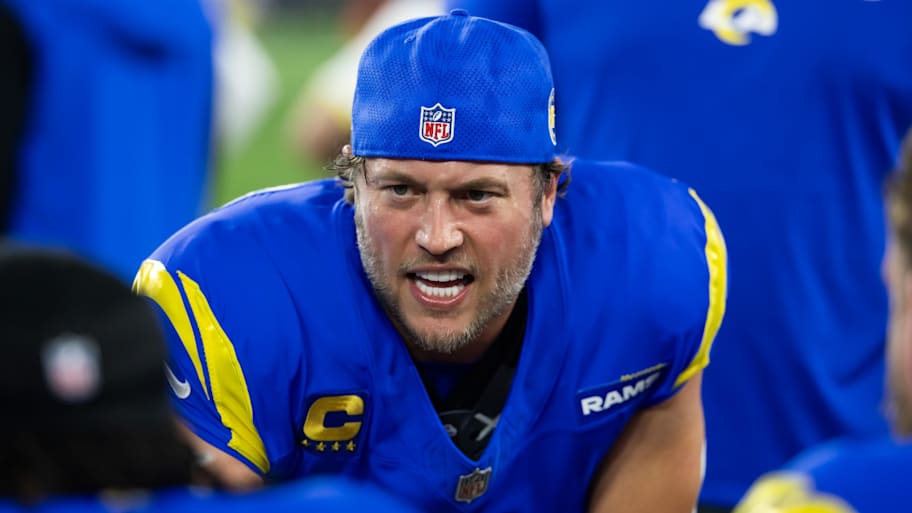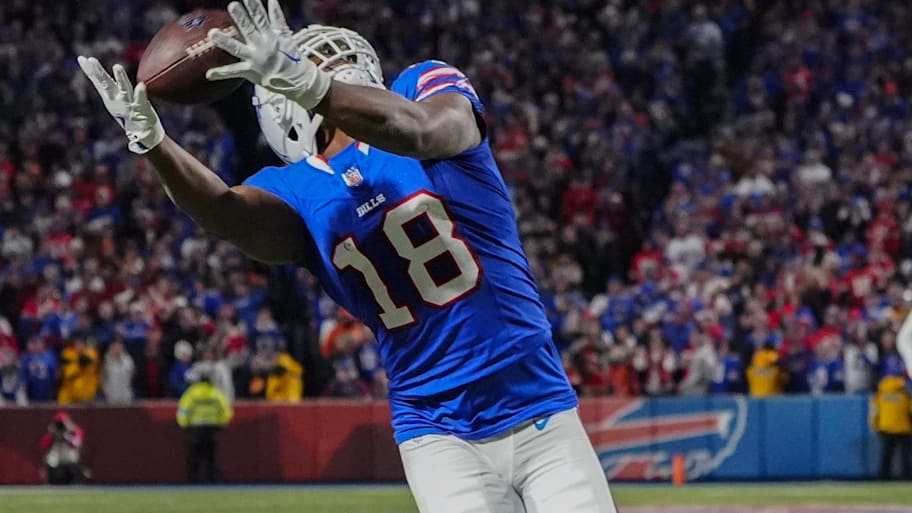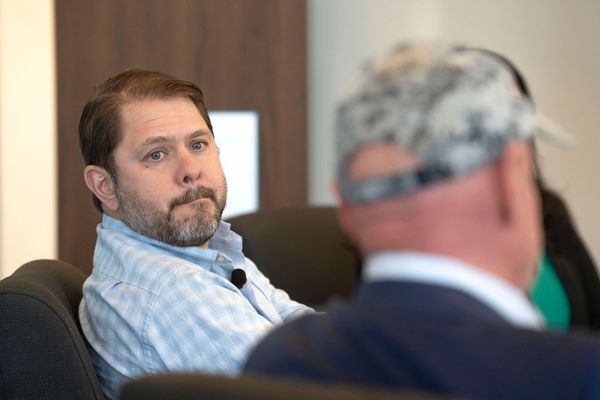
On a sleepy Tuesday morning in the NFL offseason …
• The details of Matthew Stafford’s deal, agreed to months ago, have finally emerged, and the first line in any analysis starts here: He really wanted to stay in Southern California.
The Los Angeles Rams’ bet in February and March, when they let Stafford sniff around for a trade and a new deal, was that their quarterback valued the life he’d built for his four kids in the area and the situation he had with Sean McVay. They were correct. His new deal gives him a nice bump over what he was making, for sure, and is the sort of contract adjustment teams only give to players they value at the highest level.
That said, the New York Giants and Las Vegas Raiders were willing to go a lot further, into the area where the average on a new contract would start with a five.
The Rams, in the end, gave him $80 million over the next two years, with $4 million already paid out in a March roster bonus that was, essentially, the last piece to the raise he got last year from the team before training camp. He has four $6 million option bonuses totaling $24 million (which allow the team flexibility cap-wise), and a $16 million base for this year, and an identical setup for next year. His 2025 money is fully guaranteed at signing. His ’26 money becomes fully guaranteed next March on the fifth day of the league year.
There are also eight void years on the back end of the deal, for cap purposes, which, like the option bonuses, give the Rams the ability to shape the deal to the cap however they see fit.
All right, so there are a couple of things from there to know about the contract.
First, it’s like Aaron Donald’s 2022 contract in that it’s the rare deal that’s a raise given to a player without adding years to the deal—usually the trade-off for a raise for a player with multiple years left on his deal is the team getting additional seasons of control. That’s not happening with Stafford. In Donald’s case, there were three years left on his contract. He was to make $55 million on the existing contract. The revision bumped that to $95 million. In this case, Stafford had $54 million left on his deal ($58 million if you include the roster bonus). Now, that number is $80 million ($84 million if you include the roster bonus).
So that’s a healthy $26 million raise. He had $23 million left this year, all in base salary, and was set to make $31 million next year, with a $5 million roster bonus fronting a $26 million base. That’s a $17 million jump this year, and a $9 million jump next year.
O.K., with that established, it’s still significantly less than he could’ve made. With the Raiders and Giants willing to exceed $100 million over the next two years, he walked away from around $20 million stay in California. You can say, Well, look how much he’s made already! But $20 million is $20 million. And so that makes this a little like the final deals that Peyton Manning, Drew Brees and Tom Brady signed—where those guys took a little less to stay put.
And in the final analysis, it’s another example of why NFL contracts should really only be valued through their guaranteed years. Stafford was past the guaranteed portion of his contract when he pushed for a raise last year. At signing, after the Rams won Super Bowl LVI, that deal was billed as a four-year, $160 million extension, worth $183 million over its five years. After all these machinations, if Stafford plays the next two years, he’ll wind up having made $209.015 million from 2022 to ’26.
That means the extension was actually $186.015 million over four years.
Which, to me, is well justified, because if Stafford hadn’t played up to his standard the past couple of years, then this would’ve gone the other way—and he wouldn’t make the money that isn’t guaranteed on his contract.
• I love the idea of the NFL draft being held on the National Mall in 2027,
The scene, and visuals from it, should be incredible. What makes it even more compelling is that, while it’s early, the class coming that year could be a pretty rare one, given what last year’s freshmen did in college football—with Ohio State WR Jeremiah Smith, Alabama WR Ryan Williams, Florida QB DJ Lagway, South Carolina DE Dylan Stewart and Texas pass rusher Colin Simmons among those already showing NFL potential.
Throw in the chance that Texas QB Arch Manning could wind up being part of that class, and the NFL could have a pretty cool event over the last weekend in April 2027. And, again, I’m saying that even though we’ve got a long way to go before we get there with these guys.
• What I don’t love: The proposed elimination of federal funding for traumatic brain injury and research, as ESPN’s Michael Rothstein reported Monday.
To be clear, I very much love the sport I cover. I know the difference it can make in young people’s lives, because I was once one of those young people. I don’t know where I’d be right now if I didn’t get the lessons in discipline, teamwork, determination and sacrifice that football gave me. I was a slacker in school. I got in trouble a bunch. Football gave me some direction and then, down the line, a career path.
So I have a vested interest in the sport thriving. I have a son playing now. I coach his youth team. I talk to parents about allowing their kids to play. It’s not easy. What helps most, as I see it, is knowing that work is being done to make sure that a game that’s inherently unsafe (as many sports are) is being made as safe as possible. Part of that is trying to coach the kids as responsibly as possible. Part of it is the important medical research being done.
This, by the way, won’t just affect football. It’ll affect other sports, too. It’ll affect the military. The health and well-being of the pros is a very small slice of the good this research—research that, importantly, is independent research—is doing. It’s doing, and has done, a lot of good for millions of young people, too. And I’ll get off my soapbox now.
• We covered the Atlanta Falcons’ draft class pretty extensively in the takeaways this week. I do have one more thing to add on the topic. Before the draft, Atlanta looked at what the Rams did in 2024 to restock the defense that Raheem Morris had just left behind in L.A. as a model, with GM Les Snead and coach Sean McVay landing Jared Verse in the first round, Braden Fiske in the second round, and safety Kam Kinchens in the third round.
Similarly, the Falcons wanted to come away with two players for their front, plus a nickel or safety, over the draft’s first two days. And it’s one reason why it was so important for the Falcons, if they were going to trade away their second-round pick in the move up to get James Pearce Jr., that they wound up with a Friday pick in return. The Rams obliged in the Falcons’ move back into the first round, sending them the 101st pick, which, interestingly, they were given for hiring Morris away from them in January 2024.
Atlanta then packaged a 2026 fifth-rounder with No. 101 to go up to No. 96, and land Notre Dame safety Xavier Watts. So in the end, in landing both Jalon Walker and Pearce, then Watts, they got done what they wanted to get done, with their version of the Verse-Fiske-Watts troika—even if it was a little pricey to pull it off.
• The Baltimore Ravens are very much betting now on themselves, and that they’ll have it right with some of the decisions they’ve made. Holding onto Justin Tucker for four months before letting him go in what they called a “football decision” is something that could come back to them if he’s found responsible for all he’s been accused of, the same way the optics of the second-round selection of Marshall’s Mike Green, who was twice accused of sexual assault, will be pretty bad if Green is involved in another situation like that again.
The Ravens have said that in the aftermath of the Ray Rice incident they’d have very low tolerance for players involved in cases such as these. Which means, if it’s not zero tolerance (and these cases seem to show it’s not), then the team has to get these right.
• The Raiders are doing a pretty decent job of building up their football infrastructure.
There are few coaches more accomplished or experienced than Pete Carroll, and he has two highly regarded coordinators in OC Chip Kelly and DC Patrick Graham. And now, new GM John Spytek is getting the chance to assemble similar strength in scouting, poaching college scouting directors from the Denver Broncos (new assistant GM Brian Stark) and Philadelphia Eagles (new senior personnel executive Anthony Patch). Both have worked with Spytek before.
This, to me, is the impact the new minority owners (uber-wealthy guys such as Egon Durban, Michael Meldman and Tom Wagner, whom Tom Brady helped bring aboard) are making, and fulfilling Brady’s promise to coaching candidates that it was a new day for the organization.

• Aaron Rodgers isn’t the only high-profile free agent left out there. Amari Cooper, Keenan Allen, J.K. Dobbins, Justin Simmons and a host of others are still out there, too.
So what gives? Well, there are two things. First, there’s the comp pick formula. Until April 29, signing one of those players would count against a team’s 2026 comp picks. And for the two guys who got “April 29 tenders” from their teams (Dobbins and Elijah Moore, who signed with the Buffalo Bills) that extends to July 22. Which means, for players such as these, waiting until after that deadline could mean a more robust market. Then, there’s the fact that a lot of teams want to see young players in the spring before making decisions on bringing in older players to fill holes.
(Also, for some, the idea of skipping out on all of the spring stuff isn’t horribly unappealing.)
• Twenty-six of 32 teams have their rookie minicamps this coming weekend—Travis Hunter, Cam Ward and Abdul Carter, among others, will be on NFL practice fields for the first time. Then, on Monday, all rookies will be ready to join the veterans on their teams for the rest of the offseason program.
More NFL on Sports Illustrated:
This article was originally published on www.si.com as NFL Notes: Matthew Stafford Walked Away from $20 Million to Stay in L.A..







